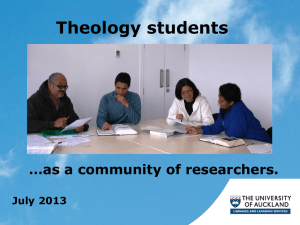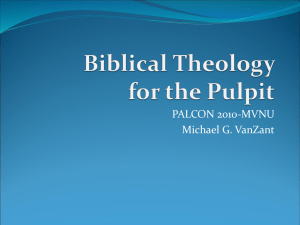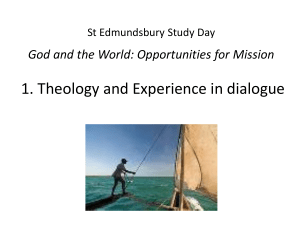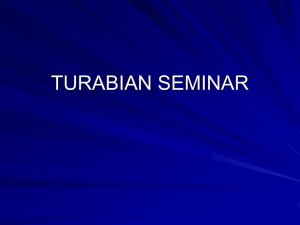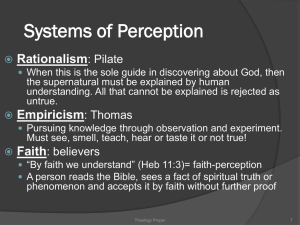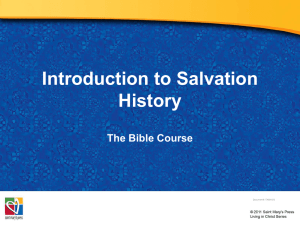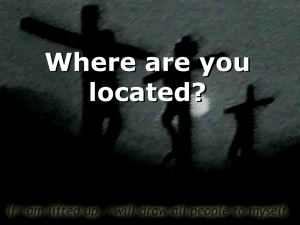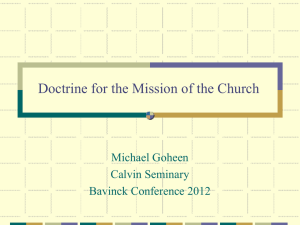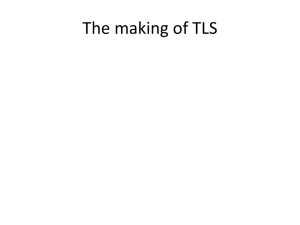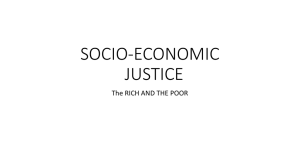Type A
advertisement
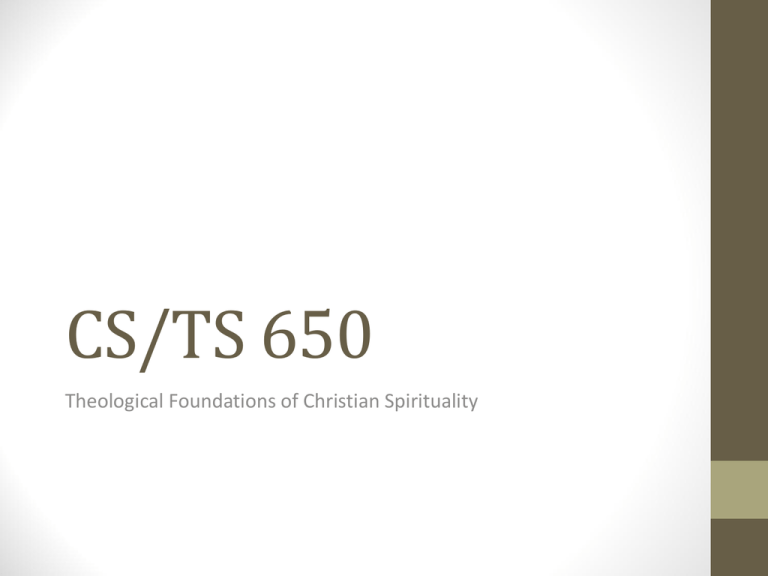
CS/TS 650 Theological Foundations of Christian Spirituality Spirituality Types (Martha Ainsworth) Theology Types Developed by Justo Gonzalez Justo Gonzalez’s Theology Types • Bevans and Schroeder’s work is based on the prior thesis of Justo Gonzalez (in Christian Thought Revisited, 1999), where he outlines three theology types: • Type A – Key Word: “Law” • Type B – Key Word: “Truth” • Type C – Key Word: “History” Constants in Context A Theology of Mission for Today Stephen B. Bevans Roger P. Schroeder The Six Constants of Mission (Constants in Context, Chapter 2) Gonzalez’s Theology Types Type A – “Law” Type B – “Truth” Type C – “History” Type D – “Holiness” (not in Gonzalez) Constants of Mission 1) 2) 3) 4) 5) 6) Christology Ecclesiology Eschatology Salvation Anthropology Culture Characterizations of Each Type Origin – Not where a particular type necessarily originated, but rather the cultural center or locale in which the earliest identifiable articulation of a specific type is expressed Culture – The milieu or setting which helped to shape or form the characteristic language of a type Characterizations of Each Type Key Figure – The historical figure (theologian) who most aptly exemplifies a particular type in its earliest expression Key Word – The term that best summarizes or encapsulates the character of a particular theological type Trajectory – A discernable line of intellectual/missional descent inspired by a particular theological type in history Type A Theology Mission as Saving Souls and Extending the Church (Constants in Context, pp. 36-49) Type A Theology Origin – Carthage Culture – Roman Key Figure – Tertullian Key Word – “Law” Trajectory – Western orthodox traditions including Medieval scholasticism, Reformation thought, and Fundamentalism. Origin and Culture Roman Carthage Tertullian (AD 170-215) Tertullian • • • • First major Christian theologian to write in Latin Probably educated as a lawyer Credited for coining the term “Trinity” Exemplifies the understanding of Christian life that became dominant in the Western church Type A Key Word: Law “In Tertullian’s writings, God is described as a lawgiver and judge, creation is conceived as wholly complete and ordered, and sin is described as going against this order and breaking divine law. Human beings are born into this world as sinners, having inherited sinfulness from first parents who originally broke God’s law and disrupted the world’s order… Key Word: Law “Jesus is depicted as the new Moses and the gospel a new law, which is a new law of repentance. If men and women submit to that law in baptism, they will be saved, and so avoid God’s punishment, provided they obey the laws of God’s church and the prescriptions of Holy Scripture” (Constants in Context, p. 38). Type A Trajectory Augustine Anselm Aquinas Luther Calvin Conservative Theology (including Fundamentalism as an extreme) Type B Theology Mission as Discovery of Truth (Constants in Context, pp. 49-61) Type B Theology Origin – Alexandria (Egypt) Culture – Hellenistic (Greek) Key Figure – Origen Key Word – Truth Trajectory – Eastern Orthodox theology; the liberal theological traditions in the West. Origin and Culture Alexandria, Egypt Alexander the Great (4th century BC) Origen of Alexandria (AD 185254) Origen • Student of Clement and his successor as the head of the famous catechetical school in Alexandria • Prolific writer who wrote commentaries on nearly every biblical book. His most famous work was On First Principles. • Steeped in Neo-Platonic thought. Type B Key Word: Truth “What is central to the perspective of Type B theology…is…the conviction that human reason can indeed come into contact – in partial but nevertheless authentic ways – with ineffable Truth” (Constants in Context, p. 50). Key Word: Truth “For Type B theology, human experience – particularly as enhanced through the power of philosophical reason – can serve ‘as a basic hermeneutical tool to understand the meaning of Scripture and the nature of Christianity’” (Constants in Context, p. 51). Type B Trajectory Peter Abelard (scholastic) Julian of Norwich (mystic) Soren Kierkegaard (existentialist) Friedrich Schleiermacher (Protestant liberalism) Paul Tillich (20th century) Type C Theology Mission as Commitment to Liberation and Transformation (Constants in Context, pp. 61-72) Type C Theology Origin – Antioch Culture – Near Eastern Key Figure – Irenaeus Key Word – History Trajectory – Popular movements; mendicant orders (Medieval); early Reformation; modern liberation theologies in the west Origin and Culture Antioch of Syria The School of Antioch • Less Romanized than Carthage; less Hellenized than Alexandria • Theology less legalistic and less abstract; more concrete, based on events of history • Emphasized literal approach to Scripture; and human nature of Christ Irenaeus (AD 130-202) Irenaeus • Early representative of Near Eastern theology • Heir to rich sub-apostolic approach that was based neither on law or philosophy, but on actually witnessed events • Developed a theological tradition rooted in the notion that all things take place within time and are guided towards God’s future Type C Key Word: History “…history in Type C theology was part of God’s plan from the beginning and not a result of a fall from some eternal state of perfection or contemplation. God created men and women in the image of God but with the task of growing into God’s full likeness. As such, they were created imperfect but were perfectible… Key Word: History “Adam and Eve had made a mistake in the Garden of Eden. By disobeying God they had, as it were, exceeded their grasp, and so fell into the servitude of the devil. But, despite sin, God as Father and Shepherd continues mercifully to lead and guide humanity throughout history… Key Word: History “God sent Jesus to free humanity from Satan’s clutches and so to make possible continued growth, until at the End all will be recapitulated in him” (Constants in Context, p. 62). Type C Trajectory Missionary work of Nestorian Church in China and India St. Francis of Assisi (Franciscan Order) Early Luther Karl Barth / Dietrich Bonhoeffer Liberation theologies Type D Theology – A Proposal • Not one of Gonzalez’s three types: • Type A – Law • Type B – Truth • Type C – History Type D Theology Origin – Western European (England) Culture – Pietistic Protestant (English) Key Figure – John Wesley Key Word – Holiness Trajectory – Methodism, Evangelicalism, Quietism (Quakers), First & Second Great Awakenings, Revivalism, Holiness Movement, Pentecostalism, Charismatic Movement NOTE: Other starting points and key figures could have been chosen for this theology type, most notably Gerard Groote and the Brethren of the Common Life (14th century) and Count Nicolas Zinzendorf and the Moravians (18th century) Type D Key Word: Holiness • Holiness as “mission” is concerned with a Christian faith that is personal, practical, and revivalistic • Moral renovation • “Personal relationship with Jesus” • Concerned with the “salvation of souls,” not merely in the sense of a “saving set of beliefs,” but a heartfelt faith that changes or transforms one’s character – a true sanctification. John Wesley (1703-1791) Aldersgate Experience “In the evening I went very unwillingly to a society in Aldersgate Street, where one was reading Luther's preface to the Epistle to the Romans. About a quarter before nine, while the leader was describing the change which God works in the heart through faith in Christ, I felt my heart strangely warmed. I felt I did trust in Christ alone for salvation; and an assurance was given me that He had taken away my sins, even mine, and saved me from the law of sin and death.” Wesley’s Journal entry (May 24, 1738) Spirituality Types (Martha Ainsworth) Theology & Spirituality Our Theological Loci • • • • • • • Scripture The Trinity Christology (Doctrine of Christ) Pneumatology (Doctrine of the Spirit) Sacraments Ecclesiology (Doctrine of the Church) Eschatology (The Kingdom of God) The Theology Types & our Theological Loci: Scripture Type A - Law Type B- Truth Type C - History Type D - Holiness Canon- fixed, cannot add or subtract Canon-closed as a matter of historical contingency Canon-closed as a matter of historical contingency Canon-fixed, cannot add or subtract Allegorical (originally) Literal Allegorical/ Figurative Literal/ Typological Literal Regulative Mythopoeic/ Legend Narrative/ Evocation Renovative Salvation through “right belief” Salvation through “finding truth” Salvation “in” and “of” history Salvation through personal change The Theology Types & our Theological Loci: Trinity Type A - Law Type B - Truth Type C - History Type D - Holiness Economic Trinity Ontological Trinity Both Economic Trinity Soteriological roles of each Person (Atonement) Ontological relation of each Person of the Divine Mystery Roles of each Person in Salvation History (Kingdom) Soteriological roles of each Person (Atonement) Salvation considered in terms of the execution of the Divine decree of election Salvation considered in terms of a participation in the Divine mystery Salvation considered in terms of the realization of the Kingdom of God Salvation considered in terms of a personal relationship (saving decision) Heterodoxy: Sabellianism, Filioquism Heterodoxy: Subordinationism Heterodoxy: Subordinationism Heterodoxy: Sabellianism, Filioquism The Theology Types & our Theological Loci: Christology Type A - Law Type B - Truth Type C - History Type D - Holiness High Christology – High or Low emphasis on divinity Low Christology – emphasis on humanity High Christology – emphasis on divinity Redemption – Satisfaction Theory Redemption – Exemplar Theory (Moral) Redemption – Ransom Theory (Liberation) Redemption – Satisfaction (for sins), Moral (for sanctification) Salvation – Exclusive Salvation – Inclusive/Pluralist Salvation – Salvation – Inclusive/ Exclusive moderate Pluralist Heterodoxy – Docetic Heterodoxy – Monophysite, Arian Heterodoxy – Nestorian Heterodoxy – Docetic High or Low Christology? High – Focus on Christ as Divine Son of God. Descriptive term: Lordship (Types A, B, D) Low – Focus on Christ as Son of Man. Descriptive term: Incarnational (Types B and C) Models of Redemption Satisfaction – Christ’s death satisfies God’s Justice (Type A, D) Exemplar – Christ’s death demonstrates the extent of God’s love (Type B, D) Liberation (Ransom) – Christ’s death frees God’s Image-bearer (humanity) from slavery to Satan (Type C) Models of Salvation Exclusive – A Christology that confesses Jesus alone as Savior (Type A, D) Inclusive – A Christology that holds out the possibility that God’s grace in Christ may be implicitly present or offered in other ways (Types B or C) Pluralist – A Christology which holds that Jesus is merely one of many ways to salvation (Types B or C) The Theology Types and our Theological Loci: Holy Spirit Type A – Law Type B – Truth Economic Trinity Ontological Trinity Both Filioque – Spirit Reject Filioque – proceeds from the Spirit proceeds Father & the Son from Father only Type C – History Spirit proceeds from the Father through the Son Type D – Holiness Economic Trinity Filioque – Spirit proceeds from the Father & the Son Concern: coequality of the Father & Son Concern: maintain Concern: maintain Concern: coproper monarchy proper roles of equality of the of the Father the Three Persons Father & Son Unity of Godhead Full Deity of Three Full disclosure of Persons the Divine in history Unity of Godhead Holy Spirit – principle of Love; rationale for elective grace (monergistic) Holy Spirit – movement/ activity communicates energies of God (synergistic) Holy Spirit – principle of Love; rationale for moral renovation; charismata (synergistic) Holy Spirit – movement/ activity defines the kingdom of God (monergistic or synergistic) Spirituality Types (Martha Ainsworth)
